Best top p&c insurance software – Expert Comparison 2025
27.10.25
Best top p&c insurance software – Expert Comparison 2025

Choosing the right insurance platform can change how a business grows and adapts. Modern solutions come packed with new ideas for policy management, claims, customer experiences, and more. So many features and approaches promise faster launches, easier connections, and smarter operations. Some products focus on automation and analytics, while others highlight flexibility or innovation. Each offers something different for insurers who want to move ahead. Curious about what sets them apart and which one fits your needs best? Read on to discover the key details that matter most.
Table of Contents
ibsuite
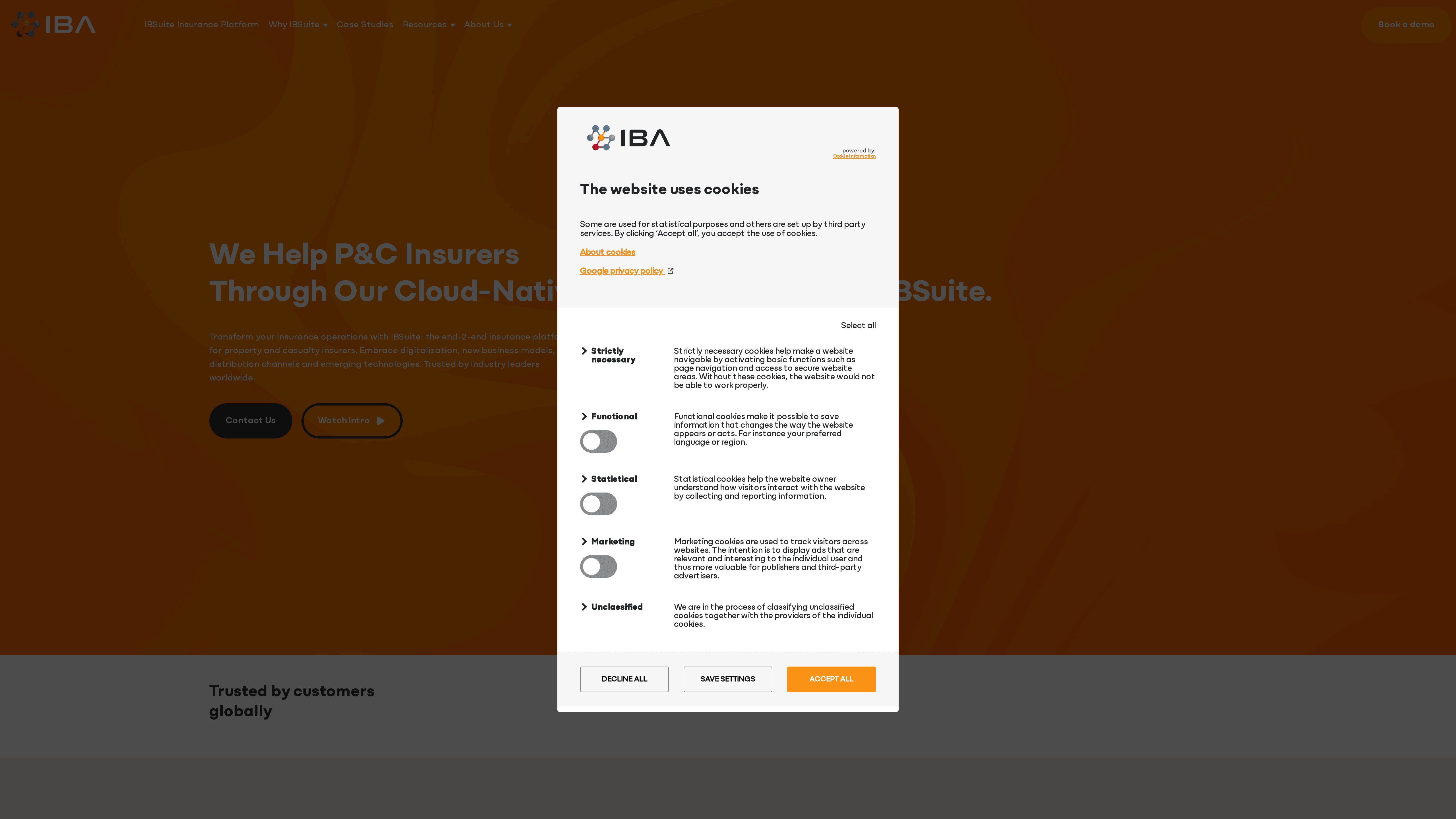
At a Glance
Insurance Business Applications (IBA) is a leading provider of cloud-native core insurance platforms for property and casualty (P&C) insurers. Since 2010, IBA has empowered insurers to accelerate digital transformation with IBSuite—a secure, API-first, end-to-end insurance platform designed to streamline operations, enable rapid product innovation, and enhance customer engagement. IBSuite is purpose-built to replace brittle legacy stacks with a single configurable platform that supports quote-to-claim workflows while delivering continuous updates and enterprise-grade security.
Core Features
IBSuite offers a cloud-native architecture that delivers scalability, flexibility, and high performance for modern insurers. Its API-first design enables seamless integration with internal systems and external partners, while configurable templates and digital models speed product launches and automation. The platform covers the full insurance value chain—quote, policy management, claims, billing, rating, CRM, and financial sub-ledger—and provides continuous, monthly upgrades so you stay current without heavy maintenance windows.
Stop. Read that again.
Pros
- Scalable and flexible cloud-native platform: IBSuite leverages cloud-native design to let you scale capacity and performance as business demands change.
- Easy integration via API-first approach: The platform’s API-first architecture simplifies connecting distribution channels, third-party services, and legacy systems.
- Regular updates with new features: Monthly upgrades ensure incremental innovation reaches your teams without disruptive rip-and-replace projects.
- Comprehensive end-to-end insurance solution: IBSuite supports quote through claim and the financial sub-ledger, reducing the need for multiple point solutions.
- Supports digital transformation and automation: Prebuilt templates and configurable workflows accelerate digitalization and reduce manual intervention across underwriting and claims.
Who It’s For
IBSuite is ideal for property and casualty insurers—carriers, MGAs, and reinsurers—that are committed to modernizing core systems, improving customer experience, and adopting cloud-first operating models. If your organization needs to reduce IT complexity, accelerate product innovation, or enable new distribution models while retaining strong governance and compliance, IBSuite fits squarely into your modernization roadmap.
Unique Value Proposition
IBSuite’s unique value lies in combining a true end-to-end insurance feature set with an API-first, cloud-native foundation and a continuous delivery model. That combination means you deploy a single platform that handles underwriting, policy admin, claims, billing, rating, CRM, and financials without stitching together multiple vendors. Continuous monthly upgrades (Evergreen updates) reduce technical debt and keep capability gaps small; the architecture is designed for rapid product launches and seamless integrations. In short: you get a secure, integrated core that reduces IT complexity, speeds time-to-market, and scales with your business—delivering measurable operational efficiency and faster innovation cycles compared to fragmented legacy approaches.
Real World Use Case
A property insurer adopts IBSuite to digitize policy administration, automate claims routing and adjudication, and launch parametric or usage-based products across new channels. Within months the insurer reduces manual touchpoints, shortens claims cycle times, and introduces targeted digital products—improving customer satisfaction while lowering operational costs.
Pricing
Quote-based — Pricing details are not specified on the website and are likely customized based on client needs.
Website: https://ibapplications.com
Duck Creek Technologies
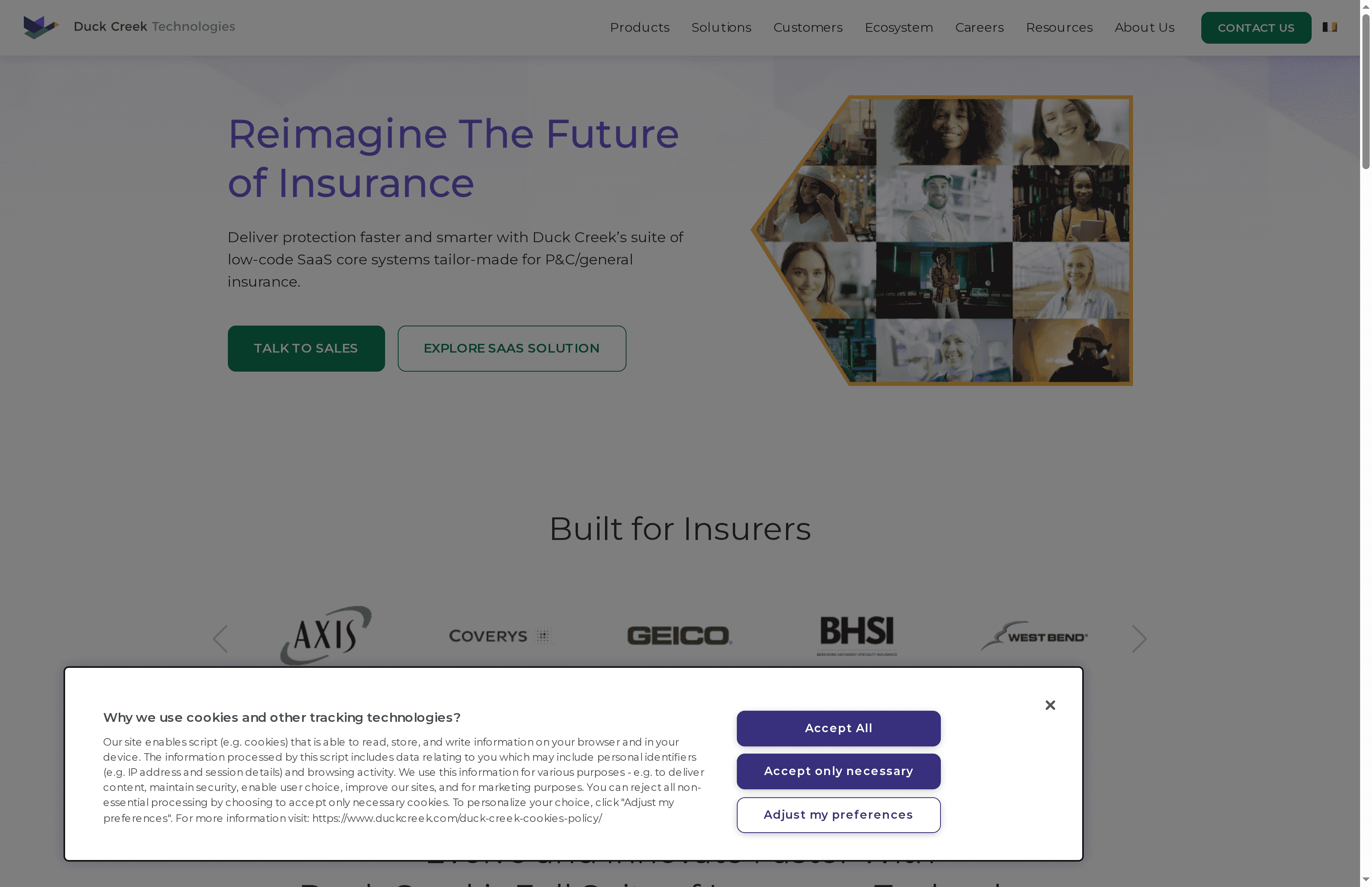
At a Glance
Duck Creek Technologies provides a low-code SaaS suite built to speed product development and modernize P&C insurance operations. It emphasizes rapid time-to-market, configurability, and integrations that extend into the global payments and partner ecosystem. Organizations that need to iterate products quickly and deliver personalized customer experiences will find Duck Creek pragmatic and purpose-built. It’s powerful — but expect a formal onboarding process and commercial discussions before you get started.
Core Features
Duck Creek’s platform centers on low-code core systems for insurance, enabling insurers to configure and reuse product modules without heavy custom coding. The suite includes native integration points with the global payments ecosystem and partnerships with leading technology providers to broaden functionality. Key capabilities reported include customizable insurance products, reusable product modules to accelerate development, and a partner ecosystem designed to support scaling distribution and operations.
Pros
- Low-code approach reduces development friction: Insurers can implement changes and configure new products without deep custom engineering, which shortens delivery cycles.
- Designed for rapid product deployment: The platform supports quick development and deployment of new P&C offerings, helping teams move from concept to market faster.
- Strong integration and partner ecosystem: Duck Creek connects with payments and third-party providers, which simplifies end-to-end workflows and extensibility.
- Proven industry footprint: With 200+ customers and over 1,100 implementations, the platform demonstrates real-world scalability and breadth of experience.
- Customer-centric design focus: The company emphasizes humanized, empathetic customer experiences, which helps insurers deliver more personalized interactions.
Cons
- Limited public detail on platform constraints: The source material does not provide specifics about architectural or functional limitations, which makes vendor evaluation less transparent.
- Pricing not publicly disclosed: Specific pricing information is not available and appears to be provided via consultation, complicating budget planning for procurement teams.
- Onboarding and training likely required: Organizations should anticipate investment in training or onboarding to realize the platform’s potential and avoid slow adoption.
Who It’s For
Duck Creek suits insurance executives, product teams, and IT architects at insurers aiming to modernize core systems without a full rewrite. If you’re leading digital transformation, need to spin up new P&C products quickly, or want to scale distribution with partner integrations, Duck Creek fits the brief. It’s particularly relevant for organizations that value configurability and have resources for structured onboarding.
Unique Value Proposition
Duck Creek’s unique value lies in combining low-code configurability with insurance-specific modules and a broad partner ecosystem, enabling insurers to iterate product lines and integrate payments and services rapidly. That combination reduces time-to-market while preserving domain-specific functionality.
Real World Use Case
A property insurer uses Duck Creek to design, test, and deploy new policy variants quickly to respond to market shifts, reusing product modules to avoid rebuilding rules and integrations — thereby improving customer engagement and accelerating time-to-revenue.
Pricing
Quote-based
Website: https://duckcreek.com
EIS Group
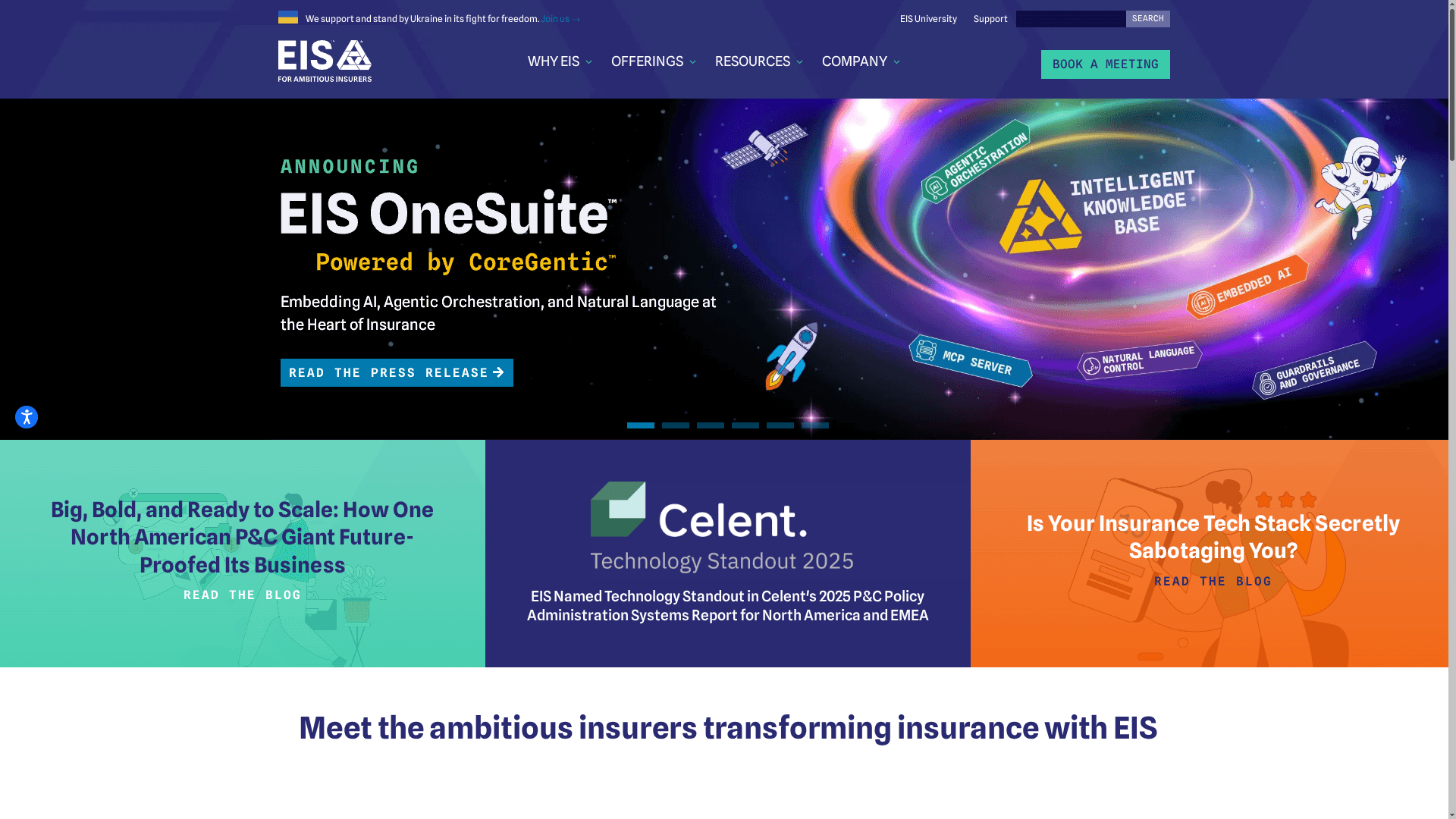
At a Glance
EIS Group provides a cloud-native, API-first SaaS core platform designed to accelerate digital transformation for insurers across P&C, life, and annuities. Its modular architecture and built-in data and analytics portals support rapid product launches and ongoing operational efficiency. For insurers focused on replacing legacy cores or launching new lines quickly, EIS offers a robust, enterprise-grade option—though buyers should expect a meaningful implementation effort. Bottom line: powerful and flexible, but not a plug-and-play shortcut.
Core Features
EIS Group combines core transformation capabilities—policy, billing, and claims management—with customer-centric tools and embedded analytics. The platform emphasizes claims automation and fraud detection workflows alongside data and analytics portals that surface actionable insights. Its cloud-native, modular design and API-first approach enable integrations and iterative product development, while adherence to international AI management standards signals governance around advanced analytics and automation.
Pros
- Scalable, modern architecture: The cloud-native and modular architecture enables insurers to scale components independently and adapt to changing volumes or product needs.
- Multi-line support: The platform supports P&C, life, and annuities, allowing carriers to consolidate core functions across multiple business lines.
- Comprehensive digital transformation tooling: EIS supplies a suite of capabilities—policy, billing, claims, analytics—that together address the full core transformation lifecycle.
- Recognized for technological rigor: The vendor highlights certification standards and innovation, which supports enterprise governance and procurement confidence.
- Fast product development: The design supports rapid product configuration and launch, helping teams shorten time to market for new insurance products.
- Rich resources and support: Extensive resources, including blogs and a resource library, help teams adopt the platform and stay informed on best practices.
Cons
- Limited public client feedback on the site: The website does not present explicit client limitations or detailed case criticisms, so independent validation is required before procurement.
- Implementation complexity is likely: Given the platform’s breadth and depth, successful deployment will require dedicated onboarding, integration effort, and training for internal teams.
- No transparent pricing: Pricing details are not published on the site, so procurement will need to engage sales for a tailored quote, which can slow initial evaluation.
Who It’s For
EIS Group is aimed at insurance carriers and large to mid-sized insurers that need to modernize core systems, consolidate multiple lines onto a single platform, or accelerate product innovation. If your team is committed to a strategic core replacement or ambitious digital roadmap and can allocate implementation resources, EIS is a strong candidate.
Unique Value Proposition
EIS combines a modern, API-first core with embedded analytics and claims automation, delivering an end-to-end platform that supports both operational efficiency and faster product launches. Its focus on modular scalability and AI governance differentiates it for enterprises seeking a governed, future-proof core.
Real World Use Case
A life insurer used EIS OneSuite™ to build a new group benefits business from scratch, accelerate digital transformation, and achieve measurable KPIs such as increased policy issuance and reduced time to market—demonstrating the platform’s suitability for scalable launches.
Pricing
Quote-based. Pricing is not specified on the website; interested parties should contact EIS for a tailored proposal.
Website: https://eisgroup.com
Guidewire

At a Glance
Guidewire delivers a comprehensive, cloud-first P&C insurance platform built to modernize core operations across policy administration, claims, and billing. It combines analytics-driven tools and broad integrations to support insurers scaling into new markets and pursuing digital transformation. Proven at scale — with deployments across hundreds of insurers — Guidewire is a strong enterprise option when you need depth and industry fit, though it can require significant integration effort and vendor engagement.
Core Features
Guidewire’s core capabilities center on a cloud-based platform (notably InsuranceNow) that supports end-to-end policy administration, claims management, and billing workflows. The suite embeds analytics and data-driven decision-making tools to improve underwriting, pricing, and operational visibility. Seamless integrations are highlighted as a purpose-built route for digital transformation, and the platform covers commercial, personal, and workers’ compensation lines to meet broad product needs.
Pros
- Comprehensive product suite: Guidewire offers a full set of policy, claims, and billing functions so you can consolidate core systems rather than stitching many point solutions together.
- Proven global footprint: With over 540 insurers in 40 countries, Guidewire demonstrates repeatable delivery and industry-specific scale across regions and product lines.
- Successful large-scale implementations: The vendor has experience with greenfield launches and core replacements, reducing program risk for complex transformations.
- Cloud deployment accelerates time-to-value: Cloud-based options support faster rollouts, scaling, and more frequent updates compared with legacy on-prem patterns.
- Focus on innovation and customer engagement: Embedded analytics and modernization pathways enable insurers to pursue better pricing accuracy and improve customer experiences.
Cons
- Pricing details are not publicly specified in the provided content, which makes initial budget planning and vendor comparison harder without direct engagement.
- Integration and customization can be significant depending on insurer complexity, so expect a meaningful program of systems, data, and process work for large incumbents.
- Managing a broad product portfolio can add operational complexity, requiring disciplined governance to ensure consistent releases and product alignment.
Who It’s For
Guidewire is aimed at insurance carriers that require a full-featured, enterprise-grade P&C core platform. If you are modernizing legacy systems, entering new markets, or need to standardize policy, claims, and billing on a single vendor platform, Guidewire suits insurers ready to invest in a structured transformation program.
Unique Value Proposition
Guidewire’s unique value lies in combining an end-to-end P&C core with analytics and cloud delivery proven across hundreds of insurers. That combination reduces the need for assembly of disparate vendors and provides a clear upgrade path for carriers seeking durable operational scale and faster product launches.
Real World Use Case
Velocity Risk used Guidewire InsuranceNow to reduce costs by 60%, double profitability within two years, and rapidly expand product offerings — demonstrating measurable financial and time-to-market gains when the platform is deployed effectively.
Pricing
Quote-based (pricing details are not specified in the provided content).
Website
Website: https://guidewire.com
Guidewire
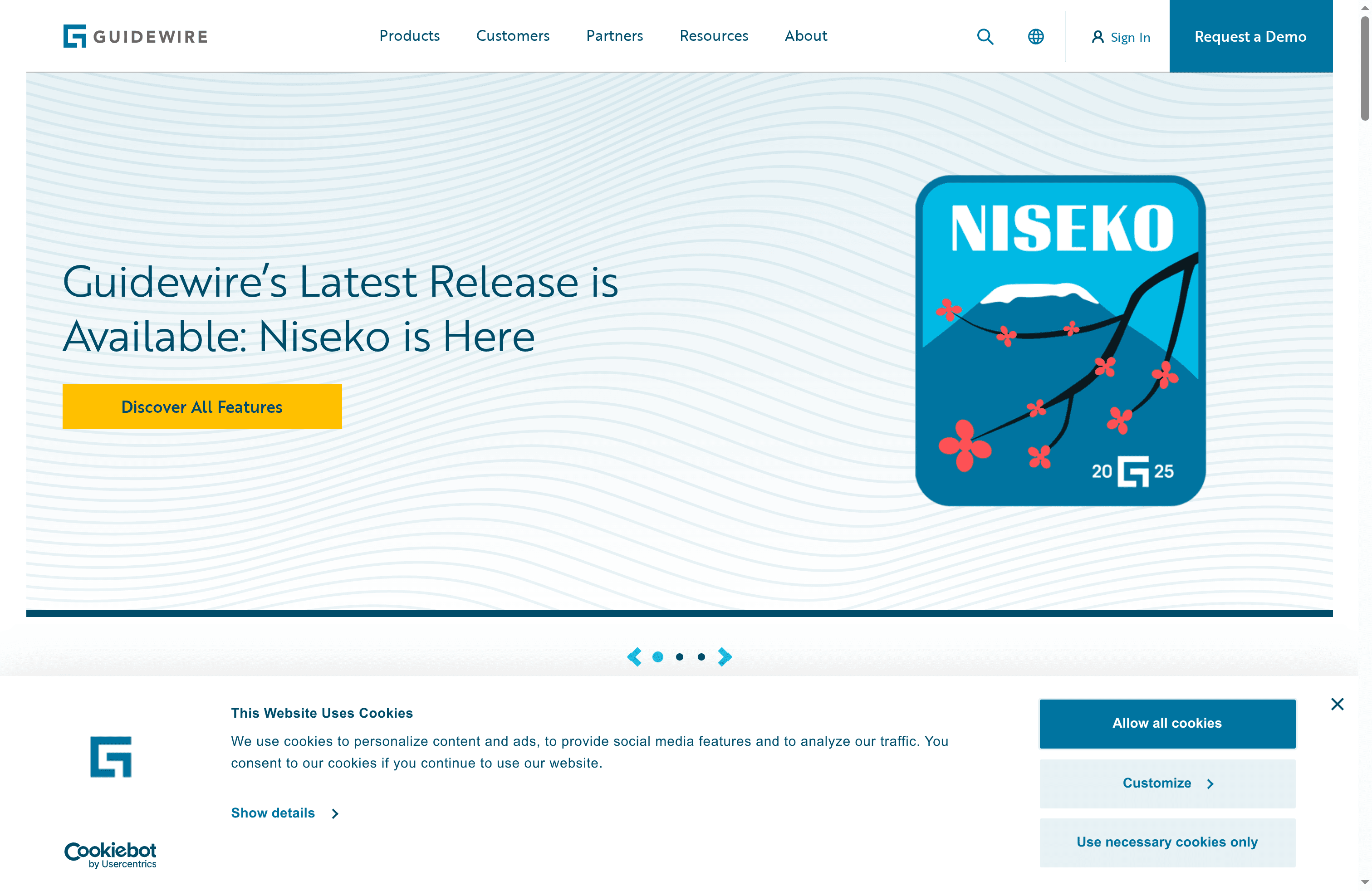
At a Glance
Guidewire is a mature, enterprise-grade P&C insurance platform focused on policy administration, claims management, billing, and a cloud platform designed to accelerate digital transformation. It combines analytics, automation, and broad integration capabilities to support insurers across commercial, personal, and workers’ compensation lines. If you need a scalable, proven core system with a strong industry community and measurable customer outcomes, Guidewire belongs on your shortlist.
Core Features
Guidewire bundles end-to-end P&C functionality—policy administration, claims management, and billing—into an all-in-one cloud platform (InsuranceNow) with embedded data analytics and automation tools. Its strengths lie in seamless integration capabilities and cloud-based deployment that enable faster implementations and ongoing operational efficiency. The platform emphasizes analytics-driven decisioning to improve underwriting, pricing, and customer engagement across the insurance value chain.
Pros
- Deep industry experience and scale: Guidewire has delivered implementations in 40+ countries and over 1,600 successful projects, which reflects strong domain knowledge and proven delivery practices.
- Comprehensive P&C functionality: The platform covers core policy, claims, and billing needs, reducing the need for multiple disconnected systems and simplifying vendor management.
- Cloud-first deployment for faster time-to-value: Guidewire’s cloud approach supports quick implementations and high uptime, enabling insurers to reduce operational costs and accelerate launches.
- Analytics and automation embedded: Built-in data analytics and automation help operational teams improve underwriting accuracy and claims handling efficiency.
- Strong reputation and user community: A large user base and active community support knowledge sharing, ecosystem extensions, and industry best practices.
Cons
- Opaque pricing for buyers: Pricing details are not publicly specified, which means procurement teams must enter quote-based negotiations without clear public benchmarks.
- Complexity can require expert services: Some insurers will need experienced implementation partners and internal change programs to realize full value, which increases project scope and cost.
- Limited public detail on feature depth: There is relatively little granular, publicly available comparative feature documentation, making vendor evaluation dependent on demos and references.
Who It’s For
Guidewire is best suited for medium-to-large P&C insurers and carriers pursuing enterprise digital transformation, scalability, and operational modernization. If your organization needs a robust, proven core platform to standardize policy, billing, and claims across multiple lines and geographies—and you’re prepared to invest in implementation and change management—Guidewire is a sensible choice.
Unique Value Proposition
Guidewire’s unique value comes from combining proven, enterprise-grade P&C capabilities with cloud delivery and integrated analytics, backed by a large install base and partner ecosystem. That mix shortens time-to-value for carriers who need to modernize legacy systems while leveraging industry-specific best practices.
Real World Use Case
Customer success examples show measurable impact: Velocity Risk used Guidewire InsuranceNow to reduce costs by 60%, doubling profitability while enabling expansion into new markets. Other carriers migrated to Guidewire Cloud to accelerate deployment and increase operational agility, and insurers improved pricing and underwriting by integrating third-party data services.
Pricing
Quote-based; pricing details are not publicly specified and are typically customized based on client needs.
Website: https://guidewire.com
Duck Creek Technologies
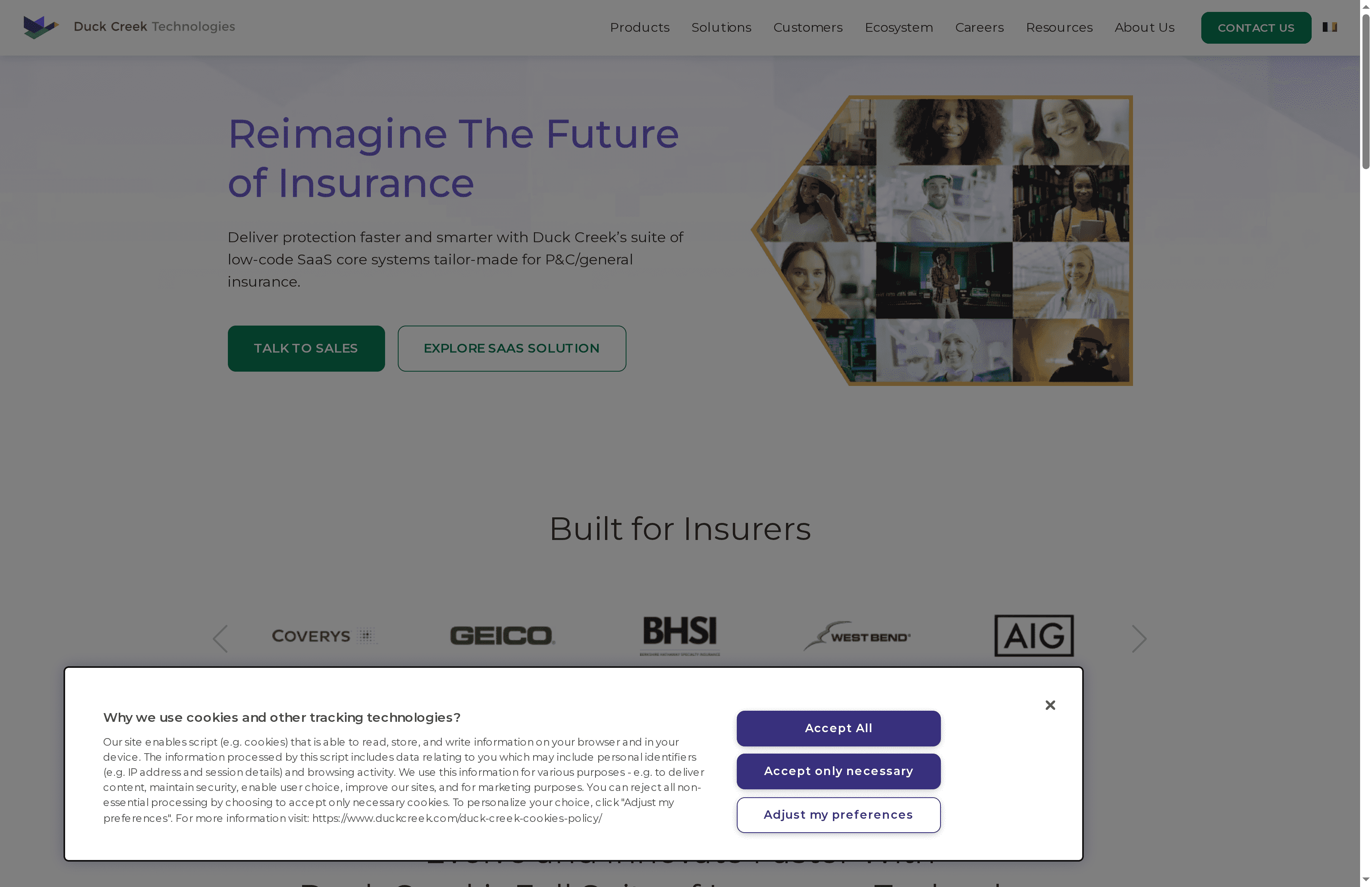
At a Glance
Duck Creek Technologies provides a low-code SaaS core suite built specifically for property and casualty insurers who need to move fast without rebuilding everything from scratch. The platform emphasizes rapid product development, broad partner integrations, and a cloud-native, scalable architecture to support growth. If you want to reduce time-to-market for new products and humanize customer journeys, Duck Creek is a serious contender — though you should expect some discovery and onboarding work up front.
Core Features
Duck Creek’s core capability is a set of low-code SaaS systems that cover the full P&C insurance lifecycle: product design and deployment, policy administration, claims handling, and payments. The platform highlights rapid product development and global payments connectivity, backed by an extensive API and partner integration framework. It also includes tools aimed at delivering personalized customer experiences and streamlining agent and broker channels. In short: configuration-first core systems with cloud scale and an ecosystem designed to accelerate innovation.
Pros
- Fast implementation and customization: The low-code configurability enables teams to implement and tailor solutions much faster than traditional, code-heavy core replacements. This reduces development cycles and dependency on heavy IT lift.
- Comprehensive lifecycle coverage: Duck Creek addresses policy administration, claims, billing/payments, and product lifecycle, giving insurers a single vendor for core process continuity.
- Strong partner ecosystem: A broad network of partners and extensive API infrastructure simplifies integration with third-party services and accelerates feature expansion.
- Scalable cloud platform: Built as a SaaS offering, the platform scales with transaction volumes and product portfolios, reducing the need to manage complex on-prem infrastructure.
- Enables rapid product innovation: The suite is explicitly designed to let insurers create and modify P&C products quickly, helping you respond to market shifts and customer needs in near real-time.
Cons
- Pricing transparency is limited: Details on costs are not published on the website, which means you must contact sales for a quote and budget planning.
- Onboarding complexity for traditional organizations: Insurers with legacy, non-cloud cultures may find the shift to low-code SaaS and modern workflows demanding and resource-intensive.
- Limited public feature detail: The website provides a high-level view but lacks granular documentation on specific modules and support levels without deeper engagement.
Who It’s For
Duck Creek is aimed at P&C insurers that are ready to modernize core systems and prioritize agility and product velocity. It suits digital transformation leaders, product teams, and IT architects who want a configurable SaaS core that reduces development overhead while enabling rapid market launches.
Unique Value Proposition
Duck Creek combines low-code configurability with a complete P&C core and a rich partner ecosystem, offering insurers a way to accelerate product innovation and scale operations without rebuilding monolithic legacy systems from the ground up.
Real World Use Case
An insurer facing a sudden market opportunity uses Duck Creek to design, test, and deploy a new P&C product within weeks rather than months, updating policy rules and rates in real time while integrating payments and distribution channels through existing partner APIs.
Pricing
Not specified, contact sales for details.
Website: https://duckcreek.com
Majesco
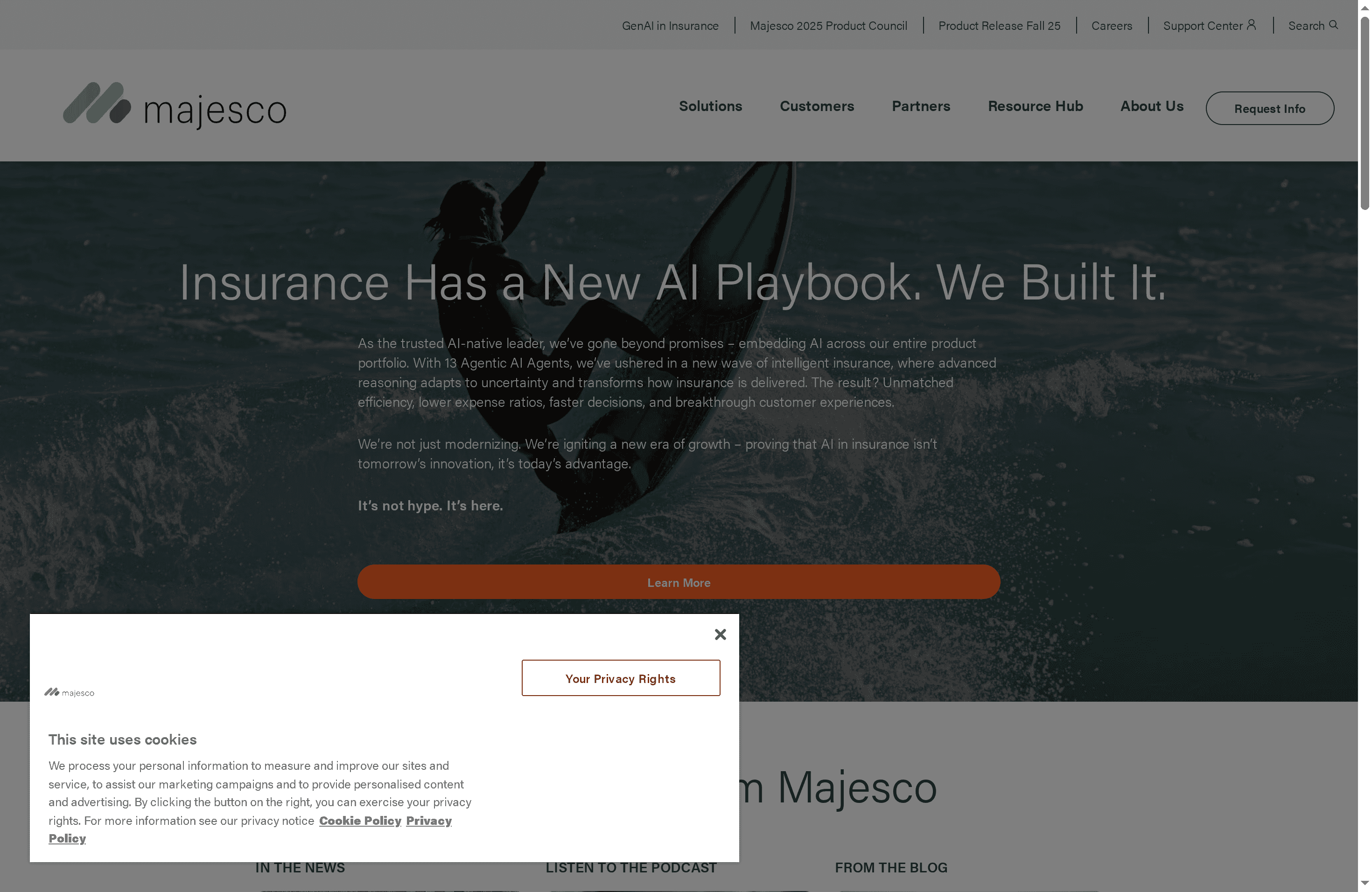
At a Glance
Majesco is an AI-native insurance technology provider focused on transforming insurance operations across P&C, life, annuity, and health lines. Its platform emphasizes agentic AI capabilities, including 13 specialized AI agents and a GenAI assistant called Majesco Copilot, designed to accelerate decision-making and operational efficiency. The vendor pairs a broad core stack for policy, billing, and claims automation with educational content—webinars, podcasts, and industry reports—that supports change management. Bottom line: Majesco is a strong choice for insurers prioritizing AI-driven modernization, though buyers should expect to dig into detailed integration and pricing specifics during procurement.
Core Features
Majesco’s core capabilities center on AI-native solutions and a full-suite approach to core systems. Highlighted features include 13 agentic AI agents for specialized workflow automation, the Majesco Copilot GenAI assistant for benchmarking and efficiency, and an MGA model office tailored to P&C core system modernization. The product set also covers policy administration, billing, and claims automation, and is supported by a steady stream of educational resources to help insurers adopt new capabilities and stay current with industry trends.
Pros
- Deep industry expertise across segments: Majesco’s portfolio spans P&C, life, annuity, and health, which helps align solutions to sector-specific needs and regulatory realities.
- Innovative AI integration providing operational efficiency: The inclusion of 13 agentic AI agents and Majesco Copilot demonstrates a clear commitment to embedding AI directly into workflows to speed decisions and reduce manual effort.
- Comprehensive product portfolio tailored to customer needs: Policy, billing, and claims automation are bundled with model-office approaches, giving insurers a cohesive modernization path rather than point solutions.
- Thought leadership and educational resources: Webinars, podcasts, and industry reports support adoption, change management, and strategy—useful when rolling out complex core changes.
- Strong recognition and partnerships in the insurtech space: The vendor’s market positioning and partner ecosystem can help accelerate implementations and integrations.
Cons
- Limited detailed feature and integration data in available materials: The provided content lacks deep technical specifics on connectors, APIs, or supported third-party ecosystems, which makes initial evaluation harder.
- Potential complexity for new clients: The breadth of solutions and advanced AI capabilities can create a steep onboarding curve without guided implementation support.
- Pricing transparency is missing: No pricing information is provided in the available content, requiring direct engagement to understand commercial fit.
Who It’s For
Majesco is best for insurers and MGAs that are committed to an AI-first modernization strategy and need an end-to-end core suite covering policy, billing, and claims. It suits digital transformation leaders and IT architects seeking vendor partners that combine product depth with educational support to drive adoption.
Unique Value Proposition
Majesco differentiates by embedding agentic AI across insurance workflows—paired with a cohesive core stack and proactive educational resources—so insurers can modernize legacy systems while shortening the time to value for AI-driven use cases.
Real World Use Case
A P&C insurer adopts Majesco’s MGA model office and Copilot to streamline policy issuance and claims triage, reducing manual touchpoints, speeding decisions, and improving benchmarking against industry peers via the platform’s GenAI assistant.
Pricing
Not specified in the provided content.
Website: https://majesco.com
Insurity
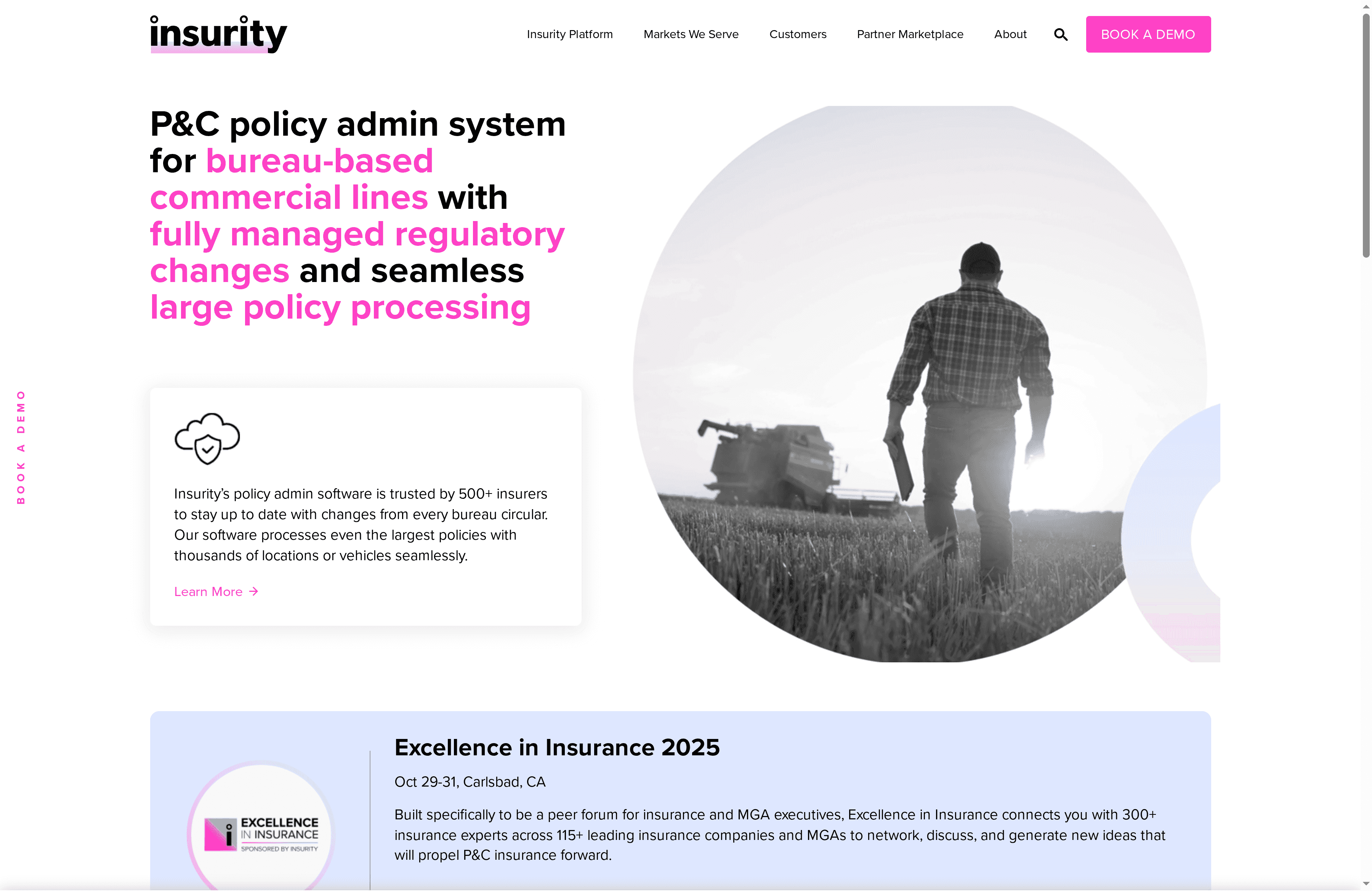
At a Glance
Insurity is a cloud-native provider of P&C insurance software built for carriers, MGAs, and risk pools that need speed and scale. The platform combines policy administration for bureau-based commercial lines, claims and billing, and a proprietary analytics stack to accelerate underwriting and claims decisions. Insurity’s strong market traction—serving over 400 cloud customers—and a stated capability to launch new products in under 30 days make it compelling for organizations prioritizing rapid time-to-market. It’s a solution built for transformation, not just incremental updates.
Core Features
Insurity’s core capabilities center on end-to-end policy administration for bureau-based commercial lines, claims and billing management, and a cloud-native analytics platform that leverages proprietary data assets. The product set is designed to support rapid product launches and to integrate through partnerships with system integrators for implementation. Together, these modules aim to streamline underwriting, automate claims workflows, and surface data-driven insights to support pricing and portfolio decisions.
Pros
- Proven cloud experience: Insurity brings over 20 years of cloud software experience, which suggests mature operational practices and platform stability.
- Large customer base: The company supports more than 400 cloud-enabled clients, indicating broad industry adoption and real-world scalability.
- Fast product launch capability: Insurity highlights the ability to deploy new insurance products in less than 30 days, enabling insurers to respond quickly to market opportunities.
- Comprehensive suite: Policy, claims, billing, and analytics are available within the same portfolio, reducing the number of vendor handoffs for core operations.
- Industry recognition: The vendor has earned awards and recognition for innovation, which can reassure buyers evaluating vendor maturity and roadmap vision.
Cons
- Limited explicit downside detail provided: Specific limitations or disadvantages are not provided in the content supplied, which makes objective gap analysis difficult.
- Pricing transparency is lacking: Pricing is not specified and likely varies based on solutions and customer needs, which means procurement will need to request custom quotes and plan for variable TCO.
Who It’s For
Insurity is targeted at carriers, managing general agents (MGAs), and risk pools that require cloud-based, scalable policy administration and end-to-end operations support. If you’re responsible for digital transformation, product innovation, or claims automation and need a vendor with demonstrated cloud deployments and rapid product rollout capability, Insurity sits squarely in your consideration set.
Unique Value Proposition
Insurity differentiates itself through a combination of cloud-native architecture, a proprietary analytics platform, and an emphasis on speed—both for deployment and new-product launches. Serving hundreds of cloud customers, it positions itself as a platform that helps insurers modernize core systems while leveraging data assets to improve underwriting and claims outcomes.
Real World Use Case
A large insurer uses Insurity’s policy management platform to consolidate commercial lines administration, automate claims workflows, and accelerate time-to-market for new products; this has enabled quicker product iterations and more data-driven underwriting decisions across their commercial book.
Pricing
Not specified; likely varies based on solutions and customer needs.
Website: https://insurity.com
Insurance Platform Tools Comparison
This table provides a concise comparison of various insurance platforms, highlighting their main features, pros, cons, and intended users to help insurers make informed decisions.
| Platform | Key Features | Pros | Cons | Pricing |
|---|---|---|---|---|
| IBSuite | Cloud-native, API-first; end-to-end solution for P&C workflows | Scalable, easy integration, regular updates | No specific cons mentioned | Quote-based |
| Duck Creek | Low-code SaaS; rapid product deployment; extensive partner ecosystem | Fast deployment, strong integration, customer-centric | Limited pricing transparency; onboarding investment needed | Quote-based |
| EIS Group | Cloud-native, API-first; modular; supports P&C, life, and annuities | Scalable, supports multiple lines, comprehensive capabilities | Requires significant onboarding; limited client feedback | Quote-based |
| Guidewire | Cloud-first; comprehensive P&C coverage; embedded analytics | Proven global success, cloud accelerates time-to-value | Integration complexity; pricing not specified | Quote-based |
| Majesco | AI-native; agentic AI capabilities; comprehensive core suite | Strong AI integration, educational resources, recognized in insurtech | Lacks detailed feature data; pricing transparency missing | Not specified |
| Insurity | Cloud-native for P&C; rapid product launch; proprietary analytics | Proven cloud track; fast launch capability; large customer base | Limited explicit downsides; pricing transparency lacking | Not specified |
Transform Your P&C Insurance Operations with IBSuite Today
The article highlights a common challenge for property and casualty insurers: the struggle to modernize complex legacy systems while accelerating product innovation and improving customer engagement. If you are facing IT complexity that slows your time-to-market or seeking a unified core platform that supports quote-to-claim workflows seamlessly, you are not alone. Many P&C insurers aim to replace fragmented systems with scalable, cloud-native solutions offering continuous updates, flexible integrations, and comprehensive functionality—from underwriting to billing and analytics.
IBSuite by Insurance Business Applications (IBA) directly addresses these pain points with a secure, API-first, end-to-end insurance platform trusted globally. Its cloud-native architecture removes traditional bottlenecks, enabling you to launch new products faster, reduce manual tasks through automation, and maintain compliance effortlessly. If you want to stop managing multiple disjointed systems and start streamlining your entire insurance value chain, now is the time to explore this proven solution.
Are you ready to accelerate your digital transformation and gain a competitive edge in P&C insurance? Discover how IBSuite can help you scale effortlessly, reduce IT complexity, and innovate at speed by booking a personalized demo. Don’t let outdated legacy systems hold you back. Take the next step toward a future-proof insurance core by scheduling your live IBSuite demo today. Learn more about how IBA helps insurers modernize core systems and embrace new distribution models with ease.
Frequently Asked Questions
What are the key factors to consider when choosing P&C insurance software?
When choosing P&C insurance software, evaluate scalability, ease of integration, and the range of features offered. Prioritize systems that support end-to-end capabilities—such as policy administration, claims management, and billing—to reduce operational complexity.
How can I assess the integration capabilities of different P&C insurance software solutions?
Assess integration capabilities by reviewing API documentation and assessing existing partnerships with third-party providers. Conduct trials to ensure seamless data flow within your existing systems, which can improve operational efficiency and reduce implementation time by up to 30%.
What implementation timeline should I expect for P&C insurance software?
Most P&C insurance software solutions have an implementation timeline ranging from a few weeks to several months, depending on the complexity of the system and your organization’s specific needs. Plan for an initial setup period of 30-60 days, followed by user training and gradual rollout.
How can P&C insurance software improve customer engagement?
P&C insurance software improves customer engagement by offering features like self-service portals, personalized communication, and streamlined claims processing. Implement these features to enhance customer experience, which can lead to a reduction in response times by approximately 20%.
What should I look for in a vendor’s support and training options?
Look for vendors that offer comprehensive training programs, responsive support, and a user community for ongoing learning. Good vendor support can significantly enhance user adoption and minimize downtime, providing access to resources as needed.
How does cloud-native architecture benefit P&C insurance software users?
Cloud-native architecture offers benefits like scalability, flexibility, and reduced IT maintenance costs. Using cloud-native solutions can improve system updates and performance, allowing teams to focus on innovation rather than infrastructure management.
Recommended
- Opportunities and Challenges for P&C Insurers: Embracing Insurtech – Digital Insurance Platform | IBSuite Insurance Software | Modern Insurance System
- 6 Types of Insurance Platforms You Should Know – Digital Insurance Platform | IBSuite Insurance Software | Modern Insurance System
- Automation and Artificial Intelligence in P&C Insurance – Digital Insurance Platform | IBSuite Insurance Software | Modern Insurance System
- 7 Policy Administration Best Practices for Insurers – Digital Insurance Platform | IBSuite Insurance Software | Modern Insurance System
- Best PPF Software 2025: Top Picks for Auto detailing businesses – AEONCUT PPF Pre-cut Cutting software